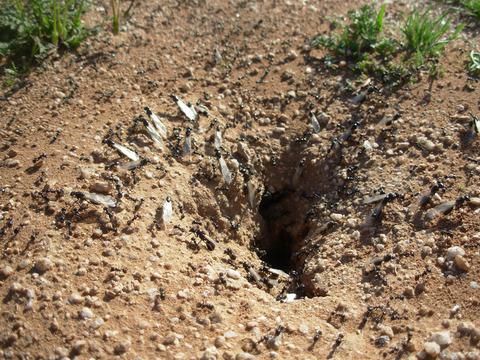当前位置:
X-MOL 学术
›
Ecol. Evol.
›
论文详情
Our official English website, www.x-mol.net, welcomes your
feedback! (Note: you will need to create a separate account there.)
Desiccation limits recruitment in the pleometrotic desert seed‐harvester ant Veromessor pergandei
Ecology and Evolution ( IF 2.3 ) Pub Date : 2020-11-22 , DOI: 10.1002/ece3.7039 Robert A Johnson 1
Ecology and Evolution ( IF 2.3 ) Pub Date : 2020-11-22 , DOI: 10.1002/ece3.7039 Robert A Johnson 1
Affiliation

|
The desert harvester ant Veromessor pergandei displays geographic variation in colony founding with queens initiating nests singly (haplometrosis) or in groups (pleometrosis). The transition from haplo‐ to pleometrotic founding is associated with lower rainfall. Numerous hypotheses have been proposed to explain the evolution of cooperative founding in this species, but the ultimate explanation remains unanswered. In laboratory experiments, water level was positively associated with survival, condition, and brood production by single queens. Queen survival also was positively influenced by water level and queen number in a two‐factor experiment. Water level also was a significant effect for three measures of queen condition, but queen number was not significant for any measure. Foundress queens excavated after two weeks of desiccating conditions were dehydrated compared to alate queens captured from their natal colony, indicating that desiccation can be a source of queen mortality. Long‐term monitoring in central Arizona, USA, documented that recruitment only occurred in four of 20 years. A discriminant analysis using rainfall as a predictor of recruitment correctly predicted recruitment in 17 of 20 years for total rainfall from January to June (the period for mating flights and establishment) and in 19 of 20 years for early plus late rainfall (January–March and April–June, respectively), often with a posterior probability > 0.90. Moreover, recruitment occurred only in years in which both early and late rainfall exceeded the long‐term mean. This result also was supported by the discriminant analysis predicting no recruitment when long‐term mean early and late rainfall were included as ungrouped periods. These data suggest that pleometrosis in V. pergandei evolved to enhance colony survival in areas with harsh abiotic (desiccating) conditions, facilitating colonization of habitats in which solitary queens could not establish even in wet years. This favorable‐year hypothesis supports enhanced worker production as the primary advantage of pleometrosis.
中文翻译:

干燥限制了多发育性沙漠种子收获蚁 Veromessor pergandei 的补充
沙漠收割蚁Veromessor pergandei在蚁群建立方面表现出地理差异,蚁后单独筑巢(单倍形)或成群(多形)。从单倍体到多倍体建立的转变与降雨量减少有关。人们提出了许多假设来解释这个物种合作建立的进化,但最终的解释仍然没有答案。在实验室实验中,水位与单蚁后的生存、状况和产卵呈正相关。在双因素实验中,水位和蜂王数量也对蜂王存活率产生积极影响。水位对于蜂王状况的三项测量也有显着影响,但蜂王数量对于任何测量都不显着。与从出生群体中捕获的已发育蜂王相比,在干燥条件两周后挖掘出的奠基蜂王脱水程度较高,这表明干燥可能是蜂王死亡的一个原因。美国亚利桑那州中部的长期监测表明,20 年中只有 4 年发生了招募。使用降雨量作为补充预测因子的判别分析正确预测了 1 月至 6 月总降雨量(交配飞行和建巢期)的 20 年中有 17 年的补充,以及早加晚降雨(1 月至 3 月和 2 月)的 20 年中的 19 年正确预测了补充。分别为 4 月至 6 月),后验概率通常 > 0.90。此外,补充仅发生在早期和晚期降雨量均超过长期平均值的年份。这一结果也得到了判别分析的支持,判别分析预测,当长期平均早期和晚期降雨被纳入未分组时期时,不会出现补充。这些数据表明,V. pergandei的侧异性进化是为了提高在非生物(干燥)条件恶劣的地区的群体存活率,促进在即使在潮湿的年份独居蜂王也无法建立的栖息地的定殖。这一有利年假说支持提高工人生产力作为侧向发育的主要优势。
更新日期:2021-01-08
中文翻译:

干燥限制了多发育性沙漠种子收获蚁 Veromessor pergandei 的补充
沙漠收割蚁Veromessor pergandei在蚁群建立方面表现出地理差异,蚁后单独筑巢(单倍形)或成群(多形)。从单倍体到多倍体建立的转变与降雨量减少有关。人们提出了许多假设来解释这个物种合作建立的进化,但最终的解释仍然没有答案。在实验室实验中,水位与单蚁后的生存、状况和产卵呈正相关。在双因素实验中,水位和蜂王数量也对蜂王存活率产生积极影响。水位对于蜂王状况的三项测量也有显着影响,但蜂王数量对于任何测量都不显着。与从出生群体中捕获的已发育蜂王相比,在干燥条件两周后挖掘出的奠基蜂王脱水程度较高,这表明干燥可能是蜂王死亡的一个原因。美国亚利桑那州中部的长期监测表明,20 年中只有 4 年发生了招募。使用降雨量作为补充预测因子的判别分析正确预测了 1 月至 6 月总降雨量(交配飞行和建巢期)的 20 年中有 17 年的补充,以及早加晚降雨(1 月至 3 月和 2 月)的 20 年中的 19 年正确预测了补充。分别为 4 月至 6 月),后验概率通常 > 0.90。此外,补充仅发生在早期和晚期降雨量均超过长期平均值的年份。这一结果也得到了判别分析的支持,判别分析预测,当长期平均早期和晚期降雨被纳入未分组时期时,不会出现补充。这些数据表明,V. pergandei的侧异性进化是为了提高在非生物(干燥)条件恶劣的地区的群体存活率,促进在即使在潮湿的年份独居蜂王也无法建立的栖息地的定殖。这一有利年假说支持提高工人生产力作为侧向发育的主要优势。









































 京公网安备 11010802027423号
京公网安备 11010802027423号